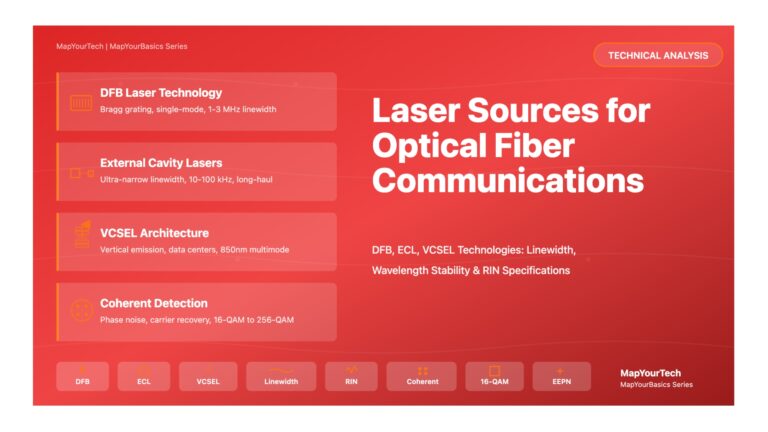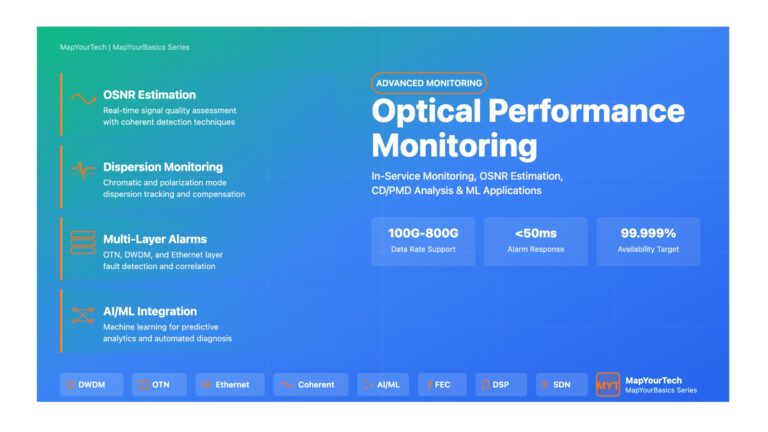Technical
Showing 61 - 70 of 573 results
800G ZR/ZR+ Coherent Optics: Comprehensive Technical Guide 800G ZR/ZR+ Coherent Optics Comprehensive Technical Guide to Next-Generation High-Speed Optical Networking Introduction...
-
Free
-
November 13, 2025
400G ZR/ZR+ Coherent Optical Technology – Comprehensive Guide | MapYourTech 400G ZR/ZR+ Coherent Optical Technology Comprehensive Guide to Next-Generation Pluggable...
-
Free
-
November 13, 2025
Inter-DC vs Intra-DC for Optical Professionals: Complete Guide Inter-DC vs Intra-DC for Optical Professionals A comprehensive guide to understanding data...
-
Free
-
November 13, 2025
Part 1: Introduction to Link Budget Analysis – MapYourTech Tutorial Series Introduction to Link Budget Analysis Master the fundamentals of...
-
Free
-
November 13, 2025
Laser Sources for Optical Fiber Communications – Comprehensive Technical Analysis Laser Sources for Optical Fiber Communications A Comprehensive Research-Grade Analysis...
-
Free
-
November 12, 2025
Data Center Interconnect: Comprehensive Technical Analysis Data Center Interconnect Technology A Comprehensive Technical Analysis of 100G/400G/800G Systems, PAM4 Modulation, and...
-
Free
-
November 12, 2025
Optical Performance Monitoring: Advanced In-Service Techniques and Machine Learning Applications Optical Performance Monitoring: Advanced In-Service Techniques and Machine Learning Applications...
-
Free
-
November 12, 2025
EDFA (Erbium Doped Fiber Amplifier): Everything You Need to Know EDFA: Erbium Doped Fiber Amplifier A comprehensive guide to the...
-
Free
-
November 9, 2025
Advanced Deep Dive: Raman Amplifier – Everything About It Advanced Deep Dive: Raman Amplifiers Comprehensive Expert-Level Analysis of Stimulated Raman...
-
Free
-
November 9, 2025
EDFA (Erbium Doped Fiber Amplifier): Complete Technical Guide – Part 1 EDFA: Erbium Doped Fiber Amplifier A Comprehensive Technical Guide...
-
Free
-
November 9, 2025
Explore Articles
Filter Articles
ResetExplore Courses
Tags
automation
ber
Chromatic Dispersion
coherent optical transmission
Data transmission
DWDM
edfa
EDFAs
Erbium-Doped Fiber Amplifiers
fec
Fiber optics
Fiber optic technology
Forward Error Correction
Latency
modulation
network automation
network management
Network performance
noise figure
optical
optical amplifiers
optical automation
Optical communication
Optical fiber
Optical network
optical network automation
optical networking
Optical networks
Optical performance
Optical signal-to-noise ratio
Optical transport network
OSNR
OTN
Q-factor
Raman Amplifier
SDH
Signal amplification
Signal integrity
Signal quality
Slider
submarine
submarine communication
submarine optical networking
Telecommunications
Ticker










